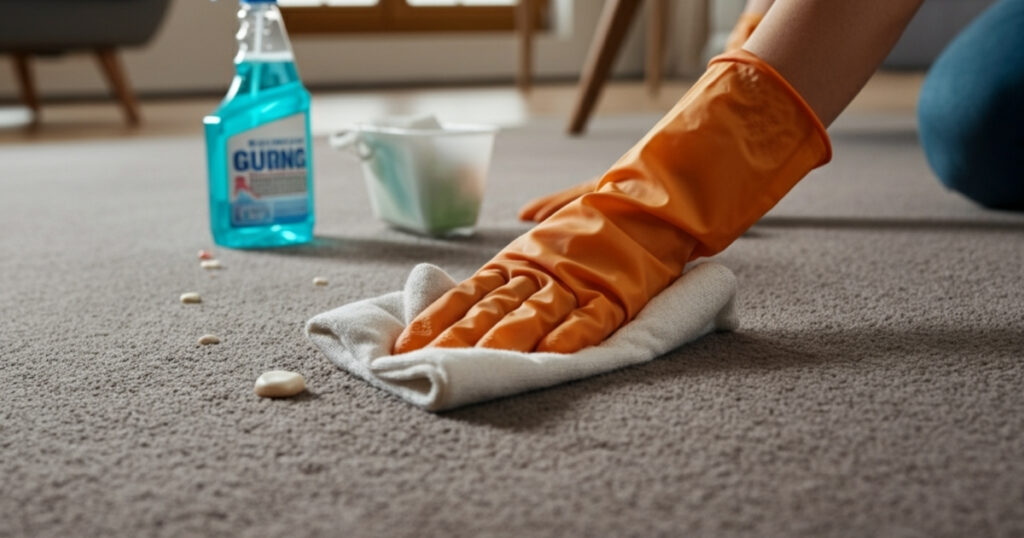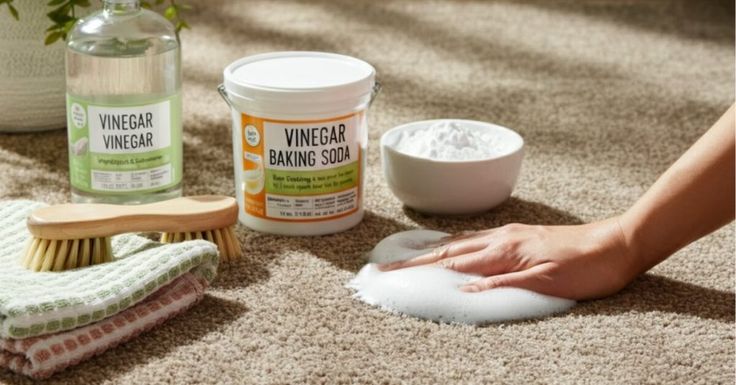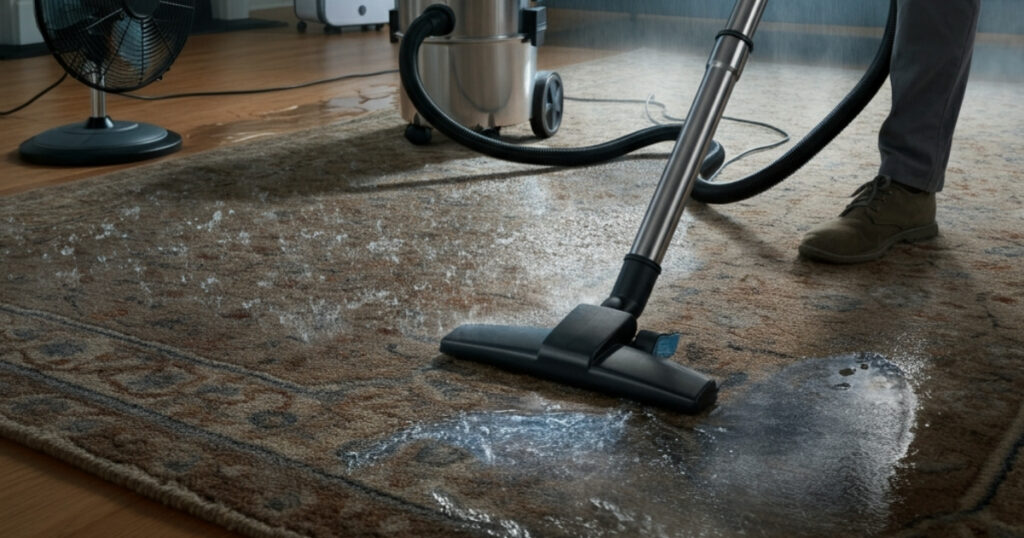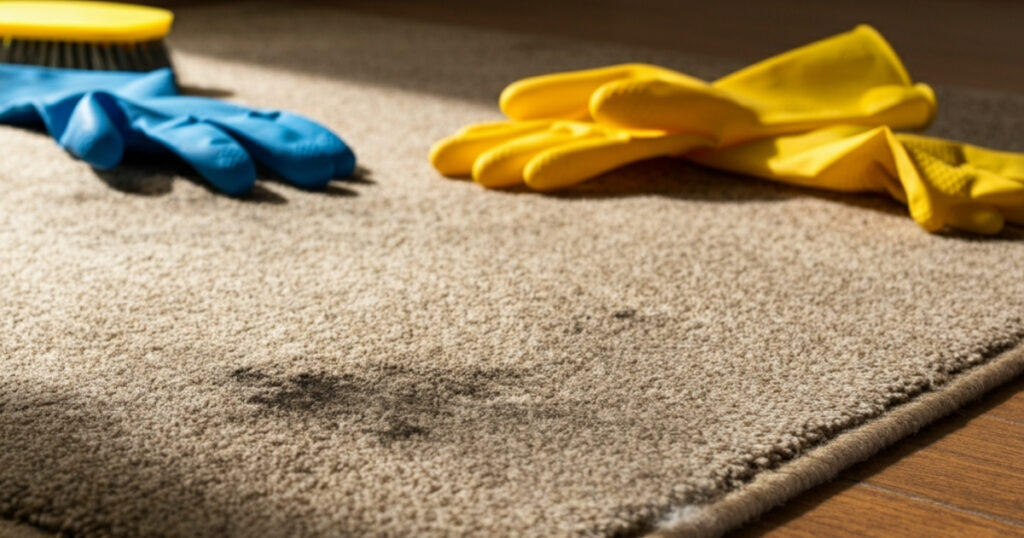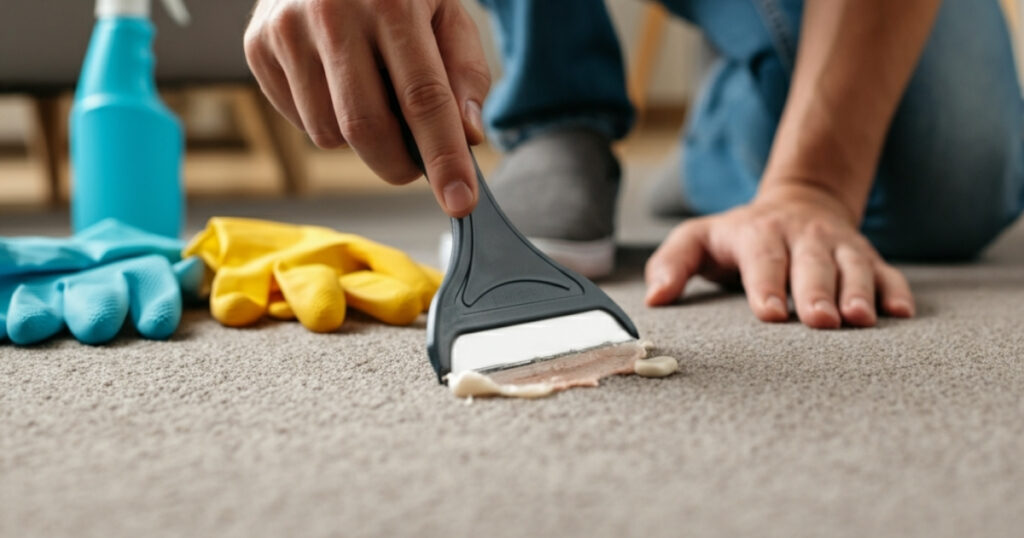As an Amazon Associate, I earn from qualifying purchases.
Getting chewing gum stuck in your carpet can feel like a nightmare, but don’t panic. Whether it’s from kids playing around or an accidental drop, removing gum from carpet fibers is completely doable with the right approach and household items.
Knowing how to get chewing gum out of carpet properly can save you from expensive professional cleaning or carpet replacement. The key lies in understanding that gum becomes easier to remove when it’s either frozen solid or heated to become more pliable. Additionally, acting quickly prevents the gum from working deeper into the carpet fibers.
This comprehensive guide will walk you through multiple proven methods to remove gum from your carpet safely and effectively. From ice cubes to peanut butter, you’ll discover various techniques that work for different carpet types and situations. Most importantly, these methods use common household items you likely already have at home.
Contents Overview
Understanding Why Gum Sticks to Carpet
Before diving into removal methods, it’s helpful to understand why chewing gum creates such a stubborn mess. Gum contains synthetic polymers and sticky resins designed to maintain elasticity and adhesion. When gum contacts carpet fibers, these polymers create strong bonds that seem impossible to break.
However, temperature changes can significantly alter gum’s properties. Cold temperatures make gum brittle and easier to break away, while heat can soften it enough to lift from fibers. Furthermore, certain oils and solvents can dissolve the sticky compounds, making removal much simpler.
The type of carpet also affects the removal process. Synthetic carpets typically handle removal methods better than natural fiber carpets, which may be more sensitive to heat and chemicals.
The Freezing Method: Ice Your Way to Success
The ice method remains one of the most popular and effective ways to remove gum from carpet. This technique works by hardening the gum until it becomes brittle enough to break away from carpet fibers.
Start by placing several ice cubes in a plastic bag to prevent water from soaking into your carpet. Press the ice bag directly onto the gum for 15-20 minutes. The goal is to freeze the gum completely solid without creating excess moisture.
Once the gum hardens, use a butter knife or spoon to gently scrape it away. Work from the outside edges of the gum toward the center to avoid spreading it further. Most of the gum should come away in chunks. For any remaining residue, repeat the freezing process.
After removing the bulk of the gum, clean the area with warm soapy water to eliminate any remaining sticky residue. Blot the area dry with a clean towel, then vacuum once the carpet is completely dry.
Heat Treatment: The Hair Dryer Approach
While freezing works well, some people find success with the opposite approach: heating the gum until it becomes pliable enough to remove. This method requires more caution to avoid damaging your carpet fibers.
Set your hair dryer to medium heat and direct it at the gum from about 6 inches away. Heat the gum for 30-60 seconds until it becomes soft and malleable. Be careful not to overheat, as excessive heat can damage carpet fibers or cause the gum to melt deeper into the carpet.
Once heated, quickly use a plastic scraper or old credit card to lift the softened gum. Work rapidly because the gum will re-harden as it cools. You may need to reheat and scrape multiple times to remove all the gum.
Clean the area afterward with a mild detergent solution to remove any remaining residue, then blot dry thoroughly.
Commercial Gum Removers: Purpose-Built Solutions
For stubborn gum removal situations, commercial gum removers offer specialized formulations designed specifically for this problem. These products typically contain solvents that dissolve gum’s sticky compounds without damaging carpet fibers.
Popular commercial options include Goo Gone, WD-40, and specialized carpet gum removers available at hardware stores. Always test these products on an inconspicuous area of your carpet first to ensure they won’t cause discoloration or damage.
Apply the commercial remover according to package directions, typically by spraying or dabbing it onto the gum and letting it sit for the recommended time. Then scrape away the dissolved gum using a plastic scraper. Clean the treated area with soap and water to remove any product residue.
The Peanut Butter Technique: Natural Oils to the Rescue
This unconventional method leverages the natural oils in peanut butter to dissolve gum’s sticky properties. While it might seem counterintuitive to add more sticky substance to your carpet, the oils in peanut butter actually help break down gum.
Choose smooth peanut butter rather than chunky to avoid additional debris. Apply a small amount directly onto the gum, working it in gently with your fingers. Let it sit for 10-15 minutes to allow the oils to penetrate and soften the gum.
Use a butter knife or spoon to scrape away both the gum and peanut butter. The gum should come away more easily thanks to the oil treatment. Clean the area thoroughly with dish soap and warm water to remove all peanut butter residue, as leaving it behind could attract dirt and create stains.
Vinegar and Oil Solutions: Kitchen Cabinet Remedies
White vinegar combined with cooking oil creates an effective homemade gum remover. The acidic vinegar helps break down gum compounds while the oil provides lubrication for easier removal.
Mix equal parts white vinegar and cooking oil (vegetable or olive oil work well) in a small bowl. Apply this mixture to the gum and let it sit for 15-20 minutes. The solution should soften the gum and make it less adhesive.
Scrape away the treated gum using a plastic tool, then clean the area with warm soapy water. This method works particularly well on older, hardened gum that has been in the carpet for some time.
Rubbing Alcohol: The Solvent Approach
Isopropyl rubbing alcohol acts as a solvent that can dissolve many of the compounds that make gum sticky. This method works especially well for removing any residual stickiness after the bulk of the gum has been removed.
Pour a small amount of rubbing alcohol onto a clean cloth and dab it onto the gum. Let it sit for a few minutes to penetrate the gum structure. Then scrape away the softened gum using a plastic scraper.
For stubborn residue, apply more alcohol and gently rub the area with the cloth. The alcohol will help dissolve remaining sticky particles. Rinse the area with water and blot dry when finished.
Professional-Grade Carpet Cleaning Methods
Sometimes gum removal requires more intensive treatment, especially if the gum has been ground deep into carpet fibers or if initial removal attempts have failed. Professional carpet cleaners have specialized tools and stronger solvents that can tackle difficult situations.
Steam cleaning can be particularly effective for final cleanup after gum removal. The high-temperature steam helps eliminate any remaining residue and sanitizes the area. If you have a home steam cleaner, use it after completing your gum removal to ensure the area is completely clean.
For valuable or delicate carpets, consider hiring professional cleaners rather than risking damage with DIY methods. They have experience with various carpet types and can recommend the safest removal approach.
Prevention Tips: Avoiding Future Gum Disasters
Once you’ve successfully removed gum from your carpet, taking preventive measures can help you avoid future incidents. Establish clear rules about where gum can be chewed, especially around carpeted areas.
Keep gum disposal options readily available throughout your home. Small trash cans with tight-fitting lids in each room make it easy for family members to dispose of gum properly.
Consider using carpet protector sprays in high-traffic areas. These products create a barrier that makes spills and sticky substances easier to clean up before they set into carpet fibers.
When to Call Professional Help
While most gum removal situations can be handled at home, certain circumstances warrant professional intervention. If the gum covers a large area or has been ground extensively into the carpet, professional cleaning may be necessary.
Similarly, if your carpet is made from delicate natural fibers like wool or silk, professional cleaners have the expertise to remove gum without causing damage. They also have access to specialized solvents and tools not available to consumers.
If your initial removal attempts have made the situation worse by spreading the gum or if you notice discoloration after treatment, stop and consult a professional before causing further damage.
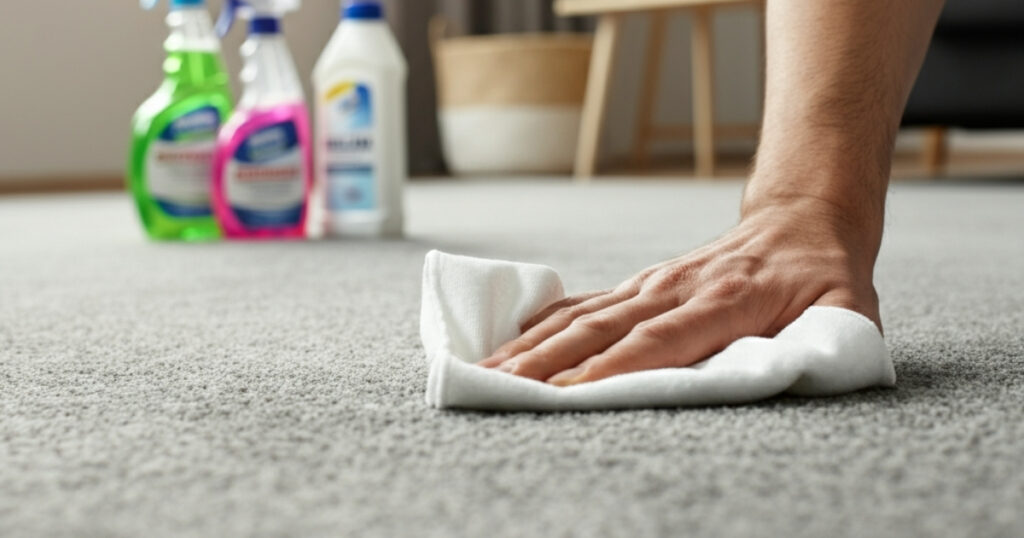
Frequently Asked Questions
1. How long should you freeze gum before trying to remove it?
Yes, freeze the gum for 15-20 minutes until it becomes completely hard and brittle before attempting removal.
2. Can you use hot water to remove gum from carpet?
No, hot water can make gum stickier and push it deeper into carpet fibers. Use cold methods or controlled heat instead.
3. Will vinegar damage my carpet?
No, white vinegar is generally safe for most carpets, but always test on an inconspicuous area first.
4. Is it safe to use WD-40 on carpet?
Yes, WD-40 can remove gum effectively, but clean the area thoroughly afterward with soap and water to remove all residue.
5. What if the gum has been in the carpet for weeks?
Yes, older gum can still be removed, though it may require multiple treatments or stronger methods like commercial removers.
6. Can I use a regular hair dryer for the heat method?
Yes, but keep it on medium heat and maintain distance to avoid overheating the carpet fibers.
7. Will these methods work on all carpet types?
No, delicate carpets like wool or antique rugs may need professional treatment to avoid damage.
8. How do I know if I’ve removed all the gum residue?
Yes, run your hand over the area – it should feel smooth without any sticky or rough spots remaining.
Getting Back to Clean Carpets
Successfully removing chewing gum from carpet requires patience and the right technique, but it’s definitely achievable with household items and proper methods. Whether you choose the freezing approach, heat treatment, or one of the solvent-based methods, the key is acting promptly and following the steps carefully.
Remember that how you get chewing gum out of carpet depends largely on your specific situation – the type of carpet, how long the gum has been there, and what removal products you have available. Don’t be discouraged if your first attempt doesn’t completely solve the problem. Sometimes combining methods or repeating treatments yields the best results.
The most important thing is to avoid panic and hasty actions that could make the situation worse. With these proven methods and a little persistence, your carpet can return to its clean, gum-free state without requiring expensive professional intervention or carpet replacement.
As an Amazon Associate, I earn from qualifying purchases.

